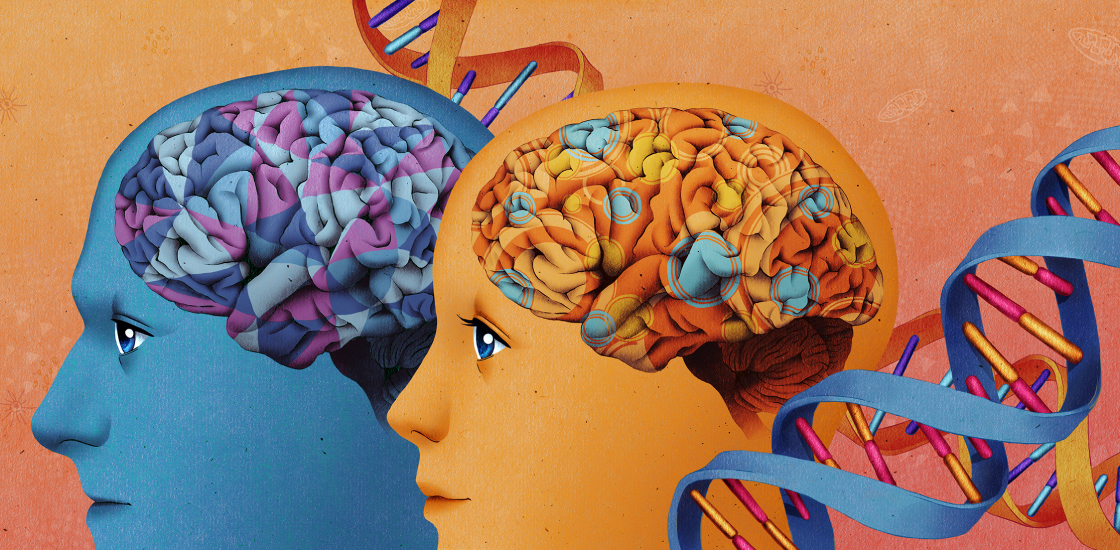THIS ARTICLE IS MORE THAN FIVE YEARS OLD
This article is more than five years old. Autism research — and science in general — is constantly evolving, so older articles may contain information or theories that have been reevaluated since their original publication date.
Genes that are expressed at higher levels in men’s brains than in women’s also tend to be enriched in the brains of people with autism. Many of these genes are markers for immune cells called microglia, which have been implicated in autism.
If elevated expression of these genes raises the risk of autism, the findings may help explain the skewed sex ratio in the condition, says lead investigator Daniel Geschwind, distinguished professor of neurology, psychiatry and human genetics at the University of California, Los Angeles. The results appeared 19 February in Nature Communications1.
The sex bias in autism is among the most-studied but least-understood aspects of the condition. Some researchers suspect that many girls with autism may go undiagnosed, either because they have subtler symptoms than boys do or because existing diagnostic tests preferentially detect boys. But others have found evidence that girls need more genetic mutations than boys do to reach the threshold for an autism diagnosis.
The new study adds to mounting support for the idea that autism’s sex bias is at least partly rooted in genetics.
“This study makes it very likely that at least some of the difference in prevalence between males and females is biological and not just about lack of recognition,” says Lauren Weiss, associate professor of psychiatry at the University of California, San Francisco, who was not involved in the work.
Intriguingly, none of the gene sets strongly linked to autism risk so far show a significant sex bias in their expression levels.
“I think what we have to do now is hunt down the link between [autism] risk genes and these genes that are differentially expressed between the sexes,” says Thomas Frazier, director of research at the Cleveland Clinic’s Center for Autism in Ohio, who is not connected to the study.
Looking for overlap:
Geschwind’s team used BrainSpan, a repository of gene expression data from postmortem brain tissue, to identify genes that are expressed differently in men and women. They focused on data from the brain’s outer layer, called the cerebral cortex, in five males and five females with no known neurological conditions. They identified 866 genes that show variable expression between the sexes.
They then looked for any overlap between these genes and four existing lists of autism-linked genes, but found no significant patterns.
The researchers then looked for crossover between the sex-skewed genes and seven sets of genes previously found to be expressed at atypical levels in postmortem brain tissue from people with autism2,3. The researchers’ list of genes that are highly expressed in males shows significant overlap with two of these sets, one with 361 genes and another with 759 genes that are highly expressed in postmortem autism brains.
Many of the shared genes in these sets are related to microglia, immune cells in the brain that trim away excess neuronal connections, or synapses, in the developing brain and that may be dysfunctional in people with autism. One of the sets also contains genes related to star-shaped cells called astrocytes, which may be involved in learning and memory; these cells are thought to be both smaller and denser in autism brains than in controls.
Finally, the researchers investigated the intersection of the sex-biased genes and 13 sets of genes that characterize certain brain cell types. They identified two gene sets specific to microglia and two to astrocytes that include many of the genes that are elevated in males.
The findings held up in two independent samples: one consisting of 10 adult brains and the other of 8 prenatal brains.
Mosaic minds:
Overall, the findings suggest that male brains are more similar to autism brains in their gene expression patterns than female brains are, says Donna Werling, a postdoctoral fellow at the University of California, San Francisco who worked on the research as a graduate student in Geschwind’s lab.
“But to really test this hypothesis, we would need to do a well-powered study of individuals that include both males and females who are autistic, as well as male and female controls,” Werling says.
It is also unclear how sex-related differences in gene expression arise in the brain. “For example, do males have a greater number of microglia than females do?” Werling says. Alternatively, it is possible that microglia in males express higher levels of these genes than females do, or that other cell types, such as neurons, express microglia genes in men but not in women, she says.
The findings back up the notion that cells other than neurons are involved in autism. “I think this adds support to those ideas that we need to keep our thinking broad in terms of what’s likely to be important or relevant,” Weiss says.

By joining the discussion, you agree to our privacy policy.